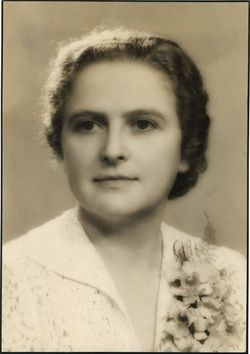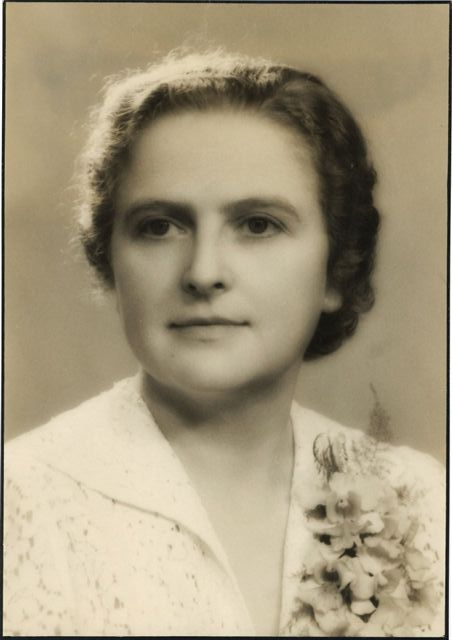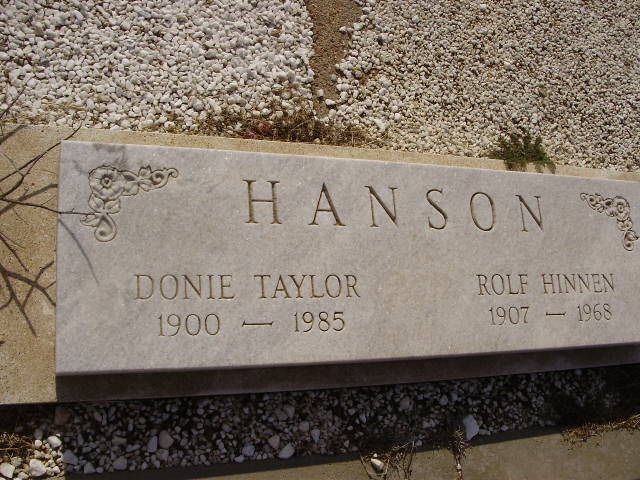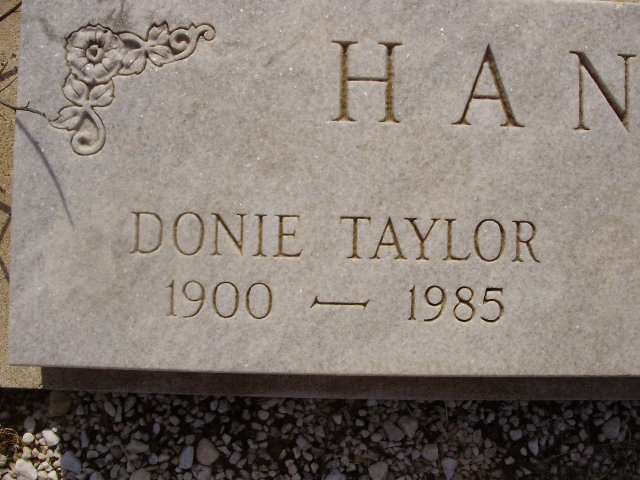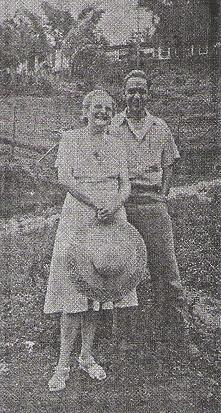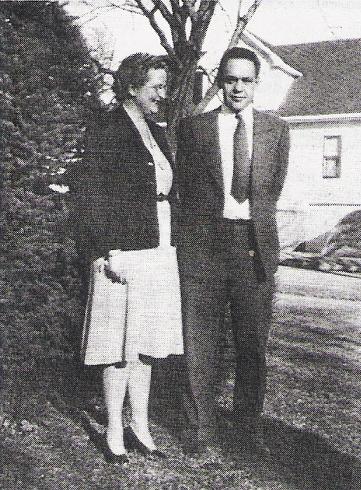Below are Donie's Memoirs about her and Rolf's life and being prisoners of war in the Philippines
DONIE
Grand-daughter of
Nancy Jane Fortenberry Brown (sweet, kind and lovable) Henry Washington Brown (gentle, shy and attentive always to the needy)
Daughter of
Harriet Virginia (Jennie) Brown (We lost her when I was only fifteen months old. Ray, my sister was thirty-one months old. Our mother was presented to us as "Perfection.")
James Whitfield Taylor (Dad was mother and father. He provided a wonderful, happy childhood.)
Wife of
Rolf Hinnen Hanson -- A very special person.
I really cherish my bond to this wonderful Fortenberry family, and my grandmother was really "My Fortenberry Star."
She carried her Fortenberry-Brown "flag high," always guiding her family with love and a very firm hand.
Members of my family were among the first early settlers in America, arriving before the Revolutionary war. Our early ones settled in Virginia, then moved on westward touching Tennessee, Missouri and Arkansas, "Strawberry area." (My mother and father were distant cousins (no kin) and I trace back to the same "greats" on both sides of Taylors and Fortenberrys.) From Arkansas they moved to Texas in the Denton County area; then SEVEN members of this Fortenberry family moved into the Texas Panhandle in early 1890's and 1900's. Many new names have been added to our clan.
Donie, "a wee twig" of this giant tree, slipped out into her world to prepare herself for teaching. I worked my way through school and financed every penny. I have been privileged to make lovely friendships at school, in my work and from my home. My good family and friends provided a special inspiration and cheer, which kept me trying earnestly "to build" Donie.
I taught in New Mexico two years and fourteen years in Alaska. I went to Alaska with the Bureau of Indian Affairs, teaching one year in the Bering Sea area, the second year in southeastern Alaska. I joined the Juneau city schools in 1926. While in Juneau I had one year's work in the Hawaiian Islands as an exchange teacher from Juneau (pay always in Juneau). I have so many wonderful "children and grandchildren" in Alaska, and I an still in touch with many of them. Alaska was a delightful place to live and work. Wonderful people and such a beautiful country Alaska is, and always will be -- "one of my first LOVES."
I met my mining engineer husband, Rolf, on my first trip to the orient.. A year later I married Rolf in Manila, Philippine Islands, We lived in the Philippines seven years, working in those beautiful mining camps. Life was good there until World War II came along and brought us the Japanese occupation.
They interned Americans, Canadians, British, Polish, Dutch, one Mexican and one Nicaraguan. (Most of these people were working out there like ourselves.) We were in a large mining area south of Manila (about one hour's flight out of Manila) when the war broke out. We "hitch-hiked" into Manila as all transportation was OUT, as was contact with Manila (a bit of good luck with some cars still running in the Provinces). We arrived in time for the saddest Christmas holidays.
The Japanese picked us up when we were having lunch in a Manila friend's home. We were told to bring food and clothing for three days, which proved to be thirty-eight months. We were placed in "Santa Tomas" (a four-hundred-year-old Spanish University -- their fine library was left and shared with us throughout the duration). Santa Tomas had "an enrollment" of two thousand to five thousand. Internees arriving from other islands and over two thousand moved to Los Banos (agricultural college). In Santa Tomas men and women were housed apart. We had meals together and could see each other daily. Rolf and I met early every morning to wash out our clothes (with many others) in our five gallon "wash" bucket. This bucket was placed in a long trough. We had running water with spigots ("creation" of our own clever men). Rolf standing on one side and Donie across from him.. (We learned to do our work early and avoid the rush and crowds).
The Japanese "walled us in" using "sawali" (woven bamboo matting). It was about six feet high and NO one had any urge to get near the walls for fear of being shot. Some had lost their lives trying to escape. We had some sad executions and abuse, and we were constantly aware the Jap guards were armed and they wouldn't hesitate to use their guns and bayonets.
Those early days in the prison camp were really rough for us. We had money in the Manila bank but couldn't get it. The Manila folks could draw supplies from their homes, for at that time their servants were still in their homes. They would bring cooked food and "pay" past the Jap guard at the gate. (Imagine the folks on the receiving line paid again -- just my conclusion.)
Red Cross supplies were stored in Manila, but the Japanese considered all captured things THEIRS, so one had to arrange "their sharing" with the prisoners. Late January, 1942, a "Red Cross Kitchen" was set up which provided for folks like ourselves. (We were so grateful for we had really been hungry, getting ONLY what some good Manila folks shared from their food baskets).
Breakfast: dish hot cereal, cup of coffee and ONE roll. No lunch. Supper: dish of soup, cup of tea and ONE roll. We survived on this and what was left over from Manila's baskets (too long). Bed and bedding was as scarce as food. I had a borrowed blanket and pillow from a Manila friend. I slept on the cement floor for six months, then had the good fortune to get a cot-bed through the Japanese release of Red Cross supplies.
In November of 1942 our English-managed Mining Company (They were operating five properties in the Philippines and had a large staff) arranged loans from Manila's wealthy Filipinos and Chinese. Our company provided a little regular, equal money allowance
for each man, woman and child of their company. We were never billed for this.
The Japanese wanted all prisoners out of Manila and made plans to move all of us to Los Banos (about one hour by car south of Manila), so "out of the blue" we had a surprise notice: "Eight hundred of the most able-bodied men" woulld be drawn to BUILD the camp for ALL the internees of the islands. My Rolf was in that draw. What a sad, sad, sad goodbye on May 14, 1943, when we saw those truck loads pull out (I was so afraid they were taking them to Japan as slave labor). We were told wives would join their husbands in two weeks; we didn't. We did hear from our husbands and bits of news was smuggled between Los Banos and Santa Tomas (at the risk of the life of those note carriers). On December 10, 1943, we joined our husbands. THAT was a happy reunion: Had a horrible trip from Manila to Los Banos. Started in trucks, then train, back to trucks to Los Banos, and counted "in and out" with every stop.
When we arrived in Los Banos we were astonished at the work our men had finished in seven months. Long rows of huge barn-shaped buildings with bath and toilets between every two buildings. The plumbing was really "created" by our men. There was a timed, large, elevated bucket which kicked off automatically and flushed the toilet "trough" clean into the cess pool every few minutes. The Japanese had planned for us to use "chick-sales," outdoor toilets in THAT hot, crowded area. Our good (elected committee talked the Japanese staff into providing these construction needs. These buildings were partitioned into little "family" areas, six feet by twelve feet, and we thought that much private space a very elegant prison home. The men had built a community kitchen and camp hospital. Of course we had ALL of the best talent in the orient, best doctors, engineers, educators and sharp business men and women. Now, I am certain, we do have the most resourceful people in the world. I've seen them adjust to hardships and "make so much out of nothing." All these buildings were made of sawali, tied with buhuka (bamboo "twine") on the "foundation" bamboo poles (all by hand -- NO NAILS). We had three meals a day in Los Banos. Food was available and cheaper (our Manila food allowance was 35 cents per person per day).
A very clever General Electric engineer "created and hooked up" electric current by pedaling a bicycle. We had his rig under the camp hospital. A radio came out of hiding and he managed to bring in some outside news. One time the Japs caught him pedaling and questioned him angrily. He insisted he was trying to create some electric current for hospital use and this was accepted.
A sugar chemist created "the makings" for soap (a shortage early in the prison). We lived in rags for the Japanese NEVER gave us a stitch of clothing. We kept remarkably free of epidemics. Hardly any medicines in the prison hospitals.
Our camps ran like any small town. We elected our seven committee members, established schools in the early days clear through high school. College courses were offered for adults or anyone who had time to attend classes. Everyone had work assignments. Even "court" was established for any correction needed (we
didn't have many). Churches were organized and everyone could have their religious comfort together.
I worked in the children's hospital in Santa Tomas and mending clothes for the 800 men who had no one to mend for then in Los Banos, Rolf was on some sort of camp patrol in Santa Tomas and worked as a bamboo "carpenter" in Los Banos (Learned a lot, too. We fully realized how the Filipinos "grew" their homes and focal.) We loved the Filipino people. We found them hard workers, clean, and they gave a warm friendship. They really helped us all they could when we were in prison, and at the risk of their lives --if the Japanese caught them aiding internees, they'd kill them.
The 'Last five months in Los Banos were really rough. The Japanese deliberately assigned us a demented commandants with instructions to starve us to death.. Meals were served only two times a day and scanty! Scanty!! Only five tablespoons of dry rice a day per person. No salt, nothing but rice! We had midmorning rice and mid-afternoon rice, saving a bit of the afternoon for a bite for early morning. This we stored in a can and hung it on a long buhuka "string" in our "window-door." We'd wake up nights because field rats were hungry, too, and searching for food, They'd run on the top boards of the partition walls and jump for our bit of food in the can. It would swing but the rat didn't get it.
I gathered and cooked pig weed by the gallon and we ate them (not with relish, but we needed a "filler"), When the Japanese lost Santa Tones to the returning Americans they decided to make ugly plans for the 706 Banos internees.
Quote from Fred Stevens' book, Santa Tomas on Los Banos:
The internees had been in the hands of the Japanese over three years. Those last months, we were told, no food was available in our area, when as a matter of fact, we knew food was abundant.
What the internees did not know was that the Japanese planned a specified date (Feb. 23, I945, at the 7 a.m. roll call) to exterminate then by machine gun fire, rifle fire, and by bayonetting. Planned to assemble them for roll call, and then in cold blood with all the savagery of Nanking and Manila, wipe them from existence in one wild, diabolical orgy of bloodshed. This the Los Banos internees did not know, but our committee received warning from a Manila Japanese who working in the Jap commandant-e's office. This fellow gave the committee complete plans of the planned massacre, even to where each guard would be stationed: Our men selected three brave internees to go over the wall at nightfall and try to reach our forces. They made a safe journey and returned with U.S. forces. We were honored with a complete volunteer group; partroopers, tankmen and guerillas. At 6:45 AM February 23rd I looked into the sunrise and saw nine huge planes come in close to our camp."Packages" started falling and grew "arms and legs" rapidly.The fall of the paratroopers was the signal for the guerillas to come in over the wall and the amphibious tanks drove in from the nearby big lake.The tanks made a "run over" on all the gun emplacements that were trained on our roll call line. Two small planes were darting back and forth over the camp. They had huge letters on their bottoms which read "RESCUE" Lots of guns firing and it seemed but minutes before our forces were in our camp. We were told the Jap guard had been wiped out. I have always wondered what happened to the Japanese office "boy" that took part in our rescue and if his superiors ever learned he'd helped us,
By eight o'clock we were loading into the tanks and across the big lake to Join Uncle Sam's boys in their "rest hospital," Muntinglupa (old P.I. prison camp). They had taken Muntinglupa only two days before our rescue. Our population count was 2,148. Our U.S. forces figured if they saved 80% of us, they'd be lucky. They didn't lose one internee. We did have some sniper fire as we were crossing the lake. It took from 8 a.m. to 5 p.m, to move -us out of camp. All the camp barracks were burned.
There was a large encampment of Japs (50,000) on the far side of the lake. When they discovered our rescue, they came in on the Los Banos area, herded all the Filipinos they could catch into the public school building, and burned them alive. They were sure the local people had aided in our escape.
Oh, how happy we were to Join our own people in Muntinglupa. They looked so healthy to us. They had such an urge to feed the ragged prisoners. At first they only gave us thin soup, for they had Santa Tomas folks overeat the rich food and they died.
Rolf and I went to Manila for we heard all the bank boxes in Manila's City National Bank of New York bad NOT been touched. We found our passports and insurance papers. While we were in Manila, travel clothes for our homeward trip were issued. They ran short so Rolf and Donie arrived in California a bit ragged. I did have a man's jacket for warmth. Los Angeles gave us such a grand welcome. Uncle Sam had arranged for tickets and travel outfits to our home towns. We were so grateful!
It took us a year to get our money out of our Manila bank. We cashed some insurance and decided to take a TWO-years rest. Those fellow internees that tried to go right into work didn't make it!
In 1947 we lined up work in Central America and spent twenty-two years down there. We had a "home base" of our own in Danli, Honduras, for fourteen years. We had planned to have our twilight years in Central America, good people, a beautiful country, and a wonderful climate. Our company had mining properties in Honduras, Nicaragua and El Salvador. We spent some time in all three countries. Made wonderful friends there, too.
Life is so different without Rolf. I do think good fortune is close to me to be able to establish my little home in Floydada, close to my people and their friends,
Our prison days have given us a special sense of values. We cherish the firm friendships and these little daily comforts that have been re-established for us.
I am so glad my grandmother Brown was a Fortenberry. She gave us MUCH to live up to! How I wish I could have known her.
Below are Donie's Memoirs about her and Rolf's life and being prisoners of war in the Philippines
DONIE
Grand-daughter of
Nancy Jane Fortenberry Brown (sweet, kind and lovable) Henry Washington Brown (gentle, shy and attentive always to the needy)
Daughter of
Harriet Virginia (Jennie) Brown (We lost her when I was only fifteen months old. Ray, my sister was thirty-one months old. Our mother was presented to us as "Perfection.")
James Whitfield Taylor (Dad was mother and father. He provided a wonderful, happy childhood.)
Wife of
Rolf Hinnen Hanson -- A very special person.
I really cherish my bond to this wonderful Fortenberry family, and my grandmother was really "My Fortenberry Star."
She carried her Fortenberry-Brown "flag high," always guiding her family with love and a very firm hand.
Members of my family were among the first early settlers in America, arriving before the Revolutionary war. Our early ones settled in Virginia, then moved on westward touching Tennessee, Missouri and Arkansas, "Strawberry area." (My mother and father were distant cousins (no kin) and I trace back to the same "greats" on both sides of Taylors and Fortenberrys.) From Arkansas they moved to Texas in the Denton County area; then SEVEN members of this Fortenberry family moved into the Texas Panhandle in early 1890's and 1900's. Many new names have been added to our clan.
Donie, "a wee twig" of this giant tree, slipped out into her world to prepare herself for teaching. I worked my way through school and financed every penny. I have been privileged to make lovely friendships at school, in my work and from my home. My good family and friends provided a special inspiration and cheer, which kept me trying earnestly "to build" Donie.
I taught in New Mexico two years and fourteen years in Alaska. I went to Alaska with the Bureau of Indian Affairs, teaching one year in the Bering Sea area, the second year in southeastern Alaska. I joined the Juneau city schools in 1926. While in Juneau I had one year's work in the Hawaiian Islands as an exchange teacher from Juneau (pay always in Juneau). I have so many wonderful "children and grandchildren" in Alaska, and I an still in touch with many of them. Alaska was a delightful place to live and work. Wonderful people and such a beautiful country Alaska is, and always will be -- "one of my first LOVES."
I met my mining engineer husband, Rolf, on my first trip to the orient.. A year later I married Rolf in Manila, Philippine Islands, We lived in the Philippines seven years, working in those beautiful mining camps. Life was good there until World War II came along and brought us the Japanese occupation.
They interned Americans, Canadians, British, Polish, Dutch, one Mexican and one Nicaraguan. (Most of these people were working out there like ourselves.) We were in a large mining area south of Manila (about one hour's flight out of Manila) when the war broke out. We "hitch-hiked" into Manila as all transportation was OUT, as was contact with Manila (a bit of good luck with some cars still running in the Provinces). We arrived in time for the saddest Christmas holidays.
The Japanese picked us up when we were having lunch in a Manila friend's home. We were told to bring food and clothing for three days, which proved to be thirty-eight months. We were placed in "Santa Tomas" (a four-hundred-year-old Spanish University -- their fine library was left and shared with us throughout the duration). Santa Tomas had "an enrollment" of two thousand to five thousand. Internees arriving from other islands and over two thousand moved to Los Banos (agricultural college). In Santa Tomas men and women were housed apart. We had meals together and could see each other daily. Rolf and I met early every morning to wash out our clothes (with many others) in our five gallon "wash" bucket. This bucket was placed in a long trough. We had running water with spigots ("creation" of our own clever men). Rolf standing on one side and Donie across from him.. (We learned to do our work early and avoid the rush and crowds).
The Japanese "walled us in" using "sawali" (woven bamboo matting). It was about six feet high and NO one had any urge to get near the walls for fear of being shot. Some had lost their lives trying to escape. We had some sad executions and abuse, and we were constantly aware the Jap guards were armed and they wouldn't hesitate to use their guns and bayonets.
Those early days in the prison camp were really rough for us. We had money in the Manila bank but couldn't get it. The Manila folks could draw supplies from their homes, for at that time their servants were still in their homes. They would bring cooked food and "pay" past the Jap guard at the gate. (Imagine the folks on the receiving line paid again -- just my conclusion.)
Red Cross supplies were stored in Manila, but the Japanese considered all captured things THEIRS, so one had to arrange "their sharing" with the prisoners. Late January, 1942, a "Red Cross Kitchen" was set up which provided for folks like ourselves. (We were so grateful for we had really been hungry, getting ONLY what some good Manila folks shared from their food baskets).
Breakfast: dish hot cereal, cup of coffee and ONE roll. No lunch. Supper: dish of soup, cup of tea and ONE roll. We survived on this and what was left over from Manila's baskets (too long). Bed and bedding was as scarce as food. I had a borrowed blanket and pillow from a Manila friend. I slept on the cement floor for six months, then had the good fortune to get a cot-bed through the Japanese release of Red Cross supplies.
In November of 1942 our English-managed Mining Company (They were operating five properties in the Philippines and had a large staff) arranged loans from Manila's wealthy Filipinos and Chinese. Our company provided a little regular, equal money allowance
for each man, woman and child of their company. We were never billed for this.
The Japanese wanted all prisoners out of Manila and made plans to move all of us to Los Banos (about one hour by car south of Manila), so "out of the blue" we had a surprise notice: "Eight hundred of the most able-bodied men" woulld be drawn to BUILD the camp for ALL the internees of the islands. My Rolf was in that draw. What a sad, sad, sad goodbye on May 14, 1943, when we saw those truck loads pull out (I was so afraid they were taking them to Japan as slave labor). We were told wives would join their husbands in two weeks; we didn't. We did hear from our husbands and bits of news was smuggled between Los Banos and Santa Tomas (at the risk of the life of those note carriers). On December 10, 1943, we joined our husbands. THAT was a happy reunion: Had a horrible trip from Manila to Los Banos. Started in trucks, then train, back to trucks to Los Banos, and counted "in and out" with every stop.
When we arrived in Los Banos we were astonished at the work our men had finished in seven months. Long rows of huge barn-shaped buildings with bath and toilets between every two buildings. The plumbing was really "created" by our men. There was a timed, large, elevated bucket which kicked off automatically and flushed the toilet "trough" clean into the cess pool every few minutes. The Japanese had planned for us to use "chick-sales," outdoor toilets in THAT hot, crowded area. Our good (elected committee talked the Japanese staff into providing these construction needs. These buildings were partitioned into little "family" areas, six feet by twelve feet, and we thought that much private space a very elegant prison home. The men had built a community kitchen and camp hospital. Of course we had ALL of the best talent in the orient, best doctors, engineers, educators and sharp business men and women. Now, I am certain, we do have the most resourceful people in the world. I've seen them adjust to hardships and "make so much out of nothing." All these buildings were made of sawali, tied with buhuka (bamboo "twine") on the "foundation" bamboo poles (all by hand -- NO NAILS). We had three meals a day in Los Banos. Food was available and cheaper (our Manila food allowance was 35 cents per person per day).
A very clever General Electric engineer "created and hooked up" electric current by pedaling a bicycle. We had his rig under the camp hospital. A radio came out of hiding and he managed to bring in some outside news. One time the Japs caught him pedaling and questioned him angrily. He insisted he was trying to create some electric current for hospital use and this was accepted.
A sugar chemist created "the makings" for soap (a shortage early in the prison). We lived in rags for the Japanese NEVER gave us a stitch of clothing. We kept remarkably free of epidemics. Hardly any medicines in the prison hospitals.
Our camps ran like any small town. We elected our seven committee members, established schools in the early days clear through high school. College courses were offered for adults or anyone who had time to attend classes. Everyone had work assignments. Even "court" was established for any correction needed (we
didn't have many). Churches were organized and everyone could have their religious comfort together.
I worked in the children's hospital in Santa Tomas and mending clothes for the 800 men who had no one to mend for then in Los Banos, Rolf was on some sort of camp patrol in Santa Tomas and worked as a bamboo "carpenter" in Los Banos (Learned a lot, too. We fully realized how the Filipinos "grew" their homes and focal.) We loved the Filipino people. We found them hard workers, clean, and they gave a warm friendship. They really helped us all they could when we were in prison, and at the risk of their lives --if the Japanese caught them aiding internees, they'd kill them.
The 'Last five months in Los Banos were really rough. The Japanese deliberately assigned us a demented commandants with instructions to starve us to death.. Meals were served only two times a day and scanty! Scanty!! Only five tablespoons of dry rice a day per person. No salt, nothing but rice! We had midmorning rice and mid-afternoon rice, saving a bit of the afternoon for a bite for early morning. This we stored in a can and hung it on a long buhuka "string" in our "window-door." We'd wake up nights because field rats were hungry, too, and searching for food, They'd run on the top boards of the partition walls and jump for our bit of food in the can. It would swing but the rat didn't get it.
I gathered and cooked pig weed by the gallon and we ate them (not with relish, but we needed a "filler"), When the Japanese lost Santa Tones to the returning Americans they decided to make ugly plans for the 706 Banos internees.
Quote from Fred Stevens' book, Santa Tomas on Los Banos:
The internees had been in the hands of the Japanese over three years. Those last months, we were told, no food was available in our area, when as a matter of fact, we knew food was abundant.
What the internees did not know was that the Japanese planned a specified date (Feb. 23, I945, at the 7 a.m. roll call) to exterminate then by machine gun fire, rifle fire, and by bayonetting. Planned to assemble them for roll call, and then in cold blood with all the savagery of Nanking and Manila, wipe them from existence in one wild, diabolical orgy of bloodshed. This the Los Banos internees did not know, but our committee received warning from a Manila Japanese who working in the Jap commandant-e's office. This fellow gave the committee complete plans of the planned massacre, even to where each guard would be stationed: Our men selected three brave internees to go over the wall at nightfall and try to reach our forces. They made a safe journey and returned with U.S. forces. We were honored with a complete volunteer group; partroopers, tankmen and guerillas. At 6:45 AM February 23rd I looked into the sunrise and saw nine huge planes come in close to our camp."Packages" started falling and grew "arms and legs" rapidly.The fall of the paratroopers was the signal for the guerillas to come in over the wall and the amphibious tanks drove in from the nearby big lake.The tanks made a "run over" on all the gun emplacements that were trained on our roll call line. Two small planes were darting back and forth over the camp. They had huge letters on their bottoms which read "RESCUE" Lots of guns firing and it seemed but minutes before our forces were in our camp. We were told the Jap guard had been wiped out. I have always wondered what happened to the Japanese office "boy" that took part in our rescue and if his superiors ever learned he'd helped us,
By eight o'clock we were loading into the tanks and across the big lake to Join Uncle Sam's boys in their "rest hospital," Muntinglupa (old P.I. prison camp). They had taken Muntinglupa only two days before our rescue. Our population count was 2,148. Our U.S. forces figured if they saved 80% of us, they'd be lucky. They didn't lose one internee. We did have some sniper fire as we were crossing the lake. It took from 8 a.m. to 5 p.m, to move -us out of camp. All the camp barracks were burned.
There was a large encampment of Japs (50,000) on the far side of the lake. When they discovered our rescue, they came in on the Los Banos area, herded all the Filipinos they could catch into the public school building, and burned them alive. They were sure the local people had aided in our escape.
Oh, how happy we were to Join our own people in Muntinglupa. They looked so healthy to us. They had such an urge to feed the ragged prisoners. At first they only gave us thin soup, for they had Santa Tomas folks overeat the rich food and they died.
Rolf and I went to Manila for we heard all the bank boxes in Manila's City National Bank of New York bad NOT been touched. We found our passports and insurance papers. While we were in Manila, travel clothes for our homeward trip were issued. They ran short so Rolf and Donie arrived in California a bit ragged. I did have a man's jacket for warmth. Los Angeles gave us such a grand welcome. Uncle Sam had arranged for tickets and travel outfits to our home towns. We were so grateful!
It took us a year to get our money out of our Manila bank. We cashed some insurance and decided to take a TWO-years rest. Those fellow internees that tried to go right into work didn't make it!
In 1947 we lined up work in Central America and spent twenty-two years down there. We had a "home base" of our own in Danli, Honduras, for fourteen years. We had planned to have our twilight years in Central America, good people, a beautiful country, and a wonderful climate. Our company had mining properties in Honduras, Nicaragua and El Salvador. We spent some time in all three countries. Made wonderful friends there, too.
Life is so different without Rolf. I do think good fortune is close to me to be able to establish my little home in Floydada, close to my people and their friends,
Our prison days have given us a special sense of values. We cherish the firm friendships and these little daily comforts that have been re-established for us.
I am so glad my grandmother Brown was a Fortenberry. She gave us MUCH to live up to! How I wish I could have known her.
